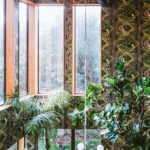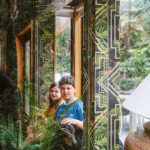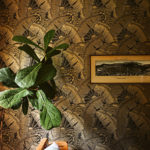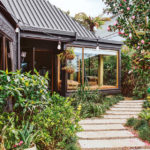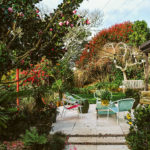Landscape designer Mike Mansvelt brings the lush outdoors into his New Plymouth home
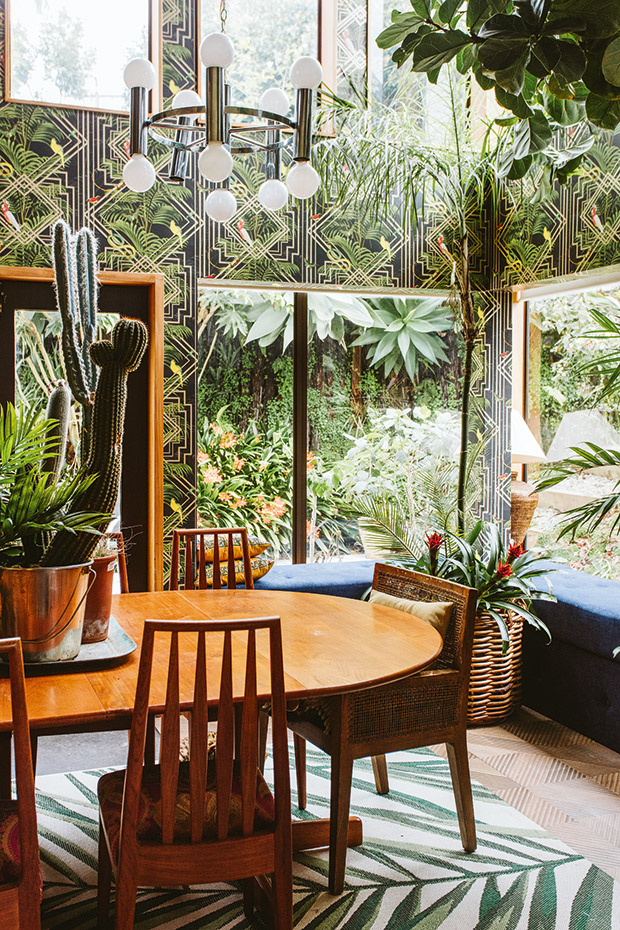
The dining-room floor is being laid in tiles after Mike over-watered the plants too many times, ruining the carpet. The light fitting is a 1980s original.
A grand designer of houses and gardens credits the elegant heritage of mid-century Hāwera for developing his eye.
Words: Lee-Anne Duncan Photos: The Virtue
Mike Mansvelt spent the past Father’s Day gardening. “Spending time in my garden is my little treat,” he says. “I love it.”
It is reassuring news to hear from a man who spends his days designing, planting and maintaining the gardens of others in New Plymouth and beyond.
“I do quite a lot of formal gardens for my clients, so I mix it up in my own. I like it a bit messy. I recharge by getting out there, spending every spare minute I can.”
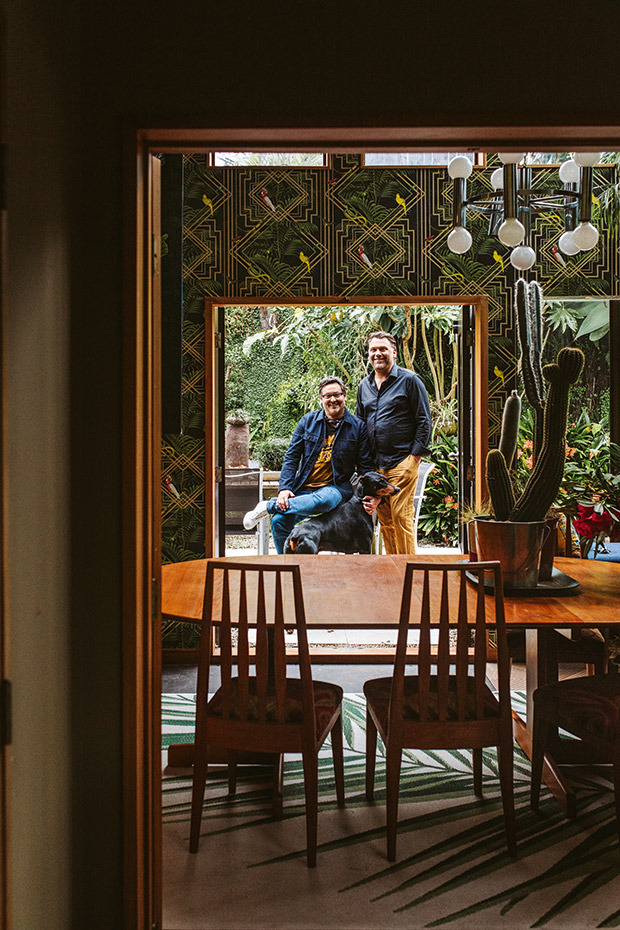
Mike (right) with fiancé, artist Reuben Paterson, and Pluto the doberman. “Reuben likes to name dogs after TV characters,” says Mike. The pair met five years ago in New Plymouth when Reuben — previously living and working in Auckland — was on a residency at the Govett-Brewster Gallery.
Not that there’s much time going spare — he is as busy as a tūī among the kōwhai, sharing four children 50/50 with his ex-wife and maintaining a business (Michael Mansvelt Designs) designing landscapes, interiors and buildings. He is also keen to nurture his relationship with his fiancé, artist Reuben Paterson.
Mike’s a true Taranaki boy, born and bred in Hāwera among a (perhaps) surprising number of mansions built during the period of high wool prices in the past century.
“I grew up in a 1960s split-level house, but all my friends had terrific California bungalows on two-acre, tree-clad sections — incredible mid-century and arts and crafts properties were left, right and centre in Hāwera. My best friend’s house was a two-storey building with leadlight windows, dark and moody. He came from Rhodesia, and it was filled with African leathers, hides and antiques. It was fabulous.
“The people next door to us had an O-shaped house built in the 1950s. It was all glass and steel with a flat roof and a tropical jungle in the central courtyard. Those homes had so much drama and piqued my interest in architecture. I’ve always been intrigued by homes and their history. The gardens, too, as they’re intertwined. And, now, here I am in a 1980s house, which is the fourth 1980s house I’ve owned. I’d love a mid-century gem or an expansive Californian bungalow, but I always seem to fall in love with 1980s houses.”
Mike left school at 16 to study commercial horticulture at the local technical institute.
- After buying his 1980s two-storey home in New Plymouth four years ago, Mike Mansvelt gave it a complete makeover. “With four kids, you don’t have an unlimited budget, so I liked the fact I could just wallpaper and make a big difference. The house was warm and sunny, and I knew it was a quality build.”
- Two of Mike’s four children — Alberta (9) and Hugo (11) — on the dining-room window seat. “Hugo said the other day, ‘This house is like a hug.’ I liked that,” says Mike, who shares the care of his children with his former wife, interior designer Alisha Barnes.
- Congo by Ralph Lauren wallpaper with an archival photo of a Ranfurly Shield match in the 1950s at Yarrow Stadium.
“That was great for me. Then I got an apprenticeship at Tūpare — a garden of national significance with an arts and crafts Tudor-style Chapman-Taylor home. With its deciduous woodland garden, it gave me a good grounding in traditional horticulture.”
Mike fell in love with the rhododendrons, camellias and magnolias of Tūpare; for their flamboyance and opulence when in flower. This is fortunate, as New Plymouth streets are lined with rhododendrons and camellias.
The city is also home to many Mike Mansvelt-designed gardens, and his work extends far beyond Taranaki to include Taupō, Matakana, Auckland and Hawke’s Bay.
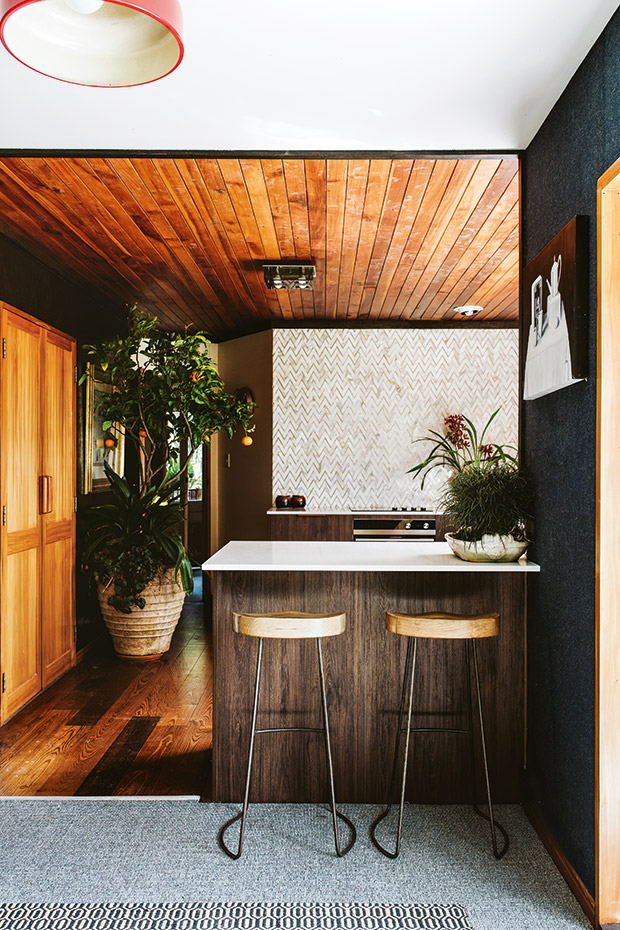
Mike recently remodelled his kitchen, adding a brass inlaid marble splashback and walnut veneer to bring the original 1980s kitchen up to date.
His skills were also honed in years overseas working with his (now former) wife, Alisha Barnes, in the dry gardens of México, then in the lush greenness of Welbeck Abbey, one of Britain’s largest privately owned estates.
“That’s where I got a taste for the way such homes were decorated; the history, the artwork, the silk wallpapers, the millions of dollars’ worth of finery.”
In the late 1990s, he and Alisha relocated to Sydney where there was a property boom and Mike learned a completely different style of gardening while working for Good Manors, a high-end residential landscape-design company.
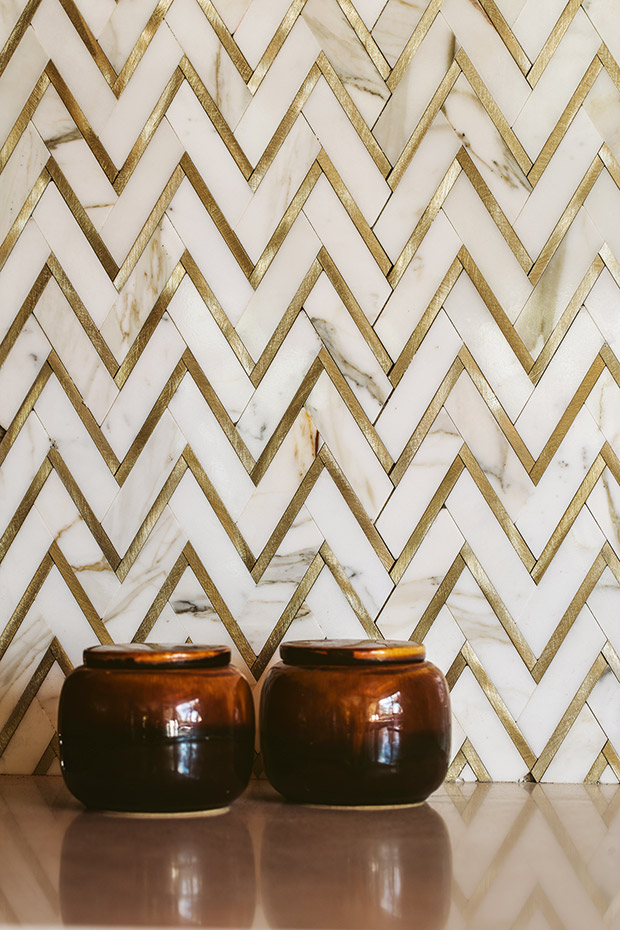
“Until that point, it had all been about cottage gardening. Then people started wanting beautiful, formal, limestone courtyards. My first day involved helicoptering big palms off a barge to a beautiful waterside place beside Tom and Nicole’s house [Cruise/Kidman, of course]. People were spending hundreds of thousands of dollars on their landscaping.”
During this time, Mike got his first chance to use expensive sub-tropicals, such as orchids, palms and many types of philodendrons.
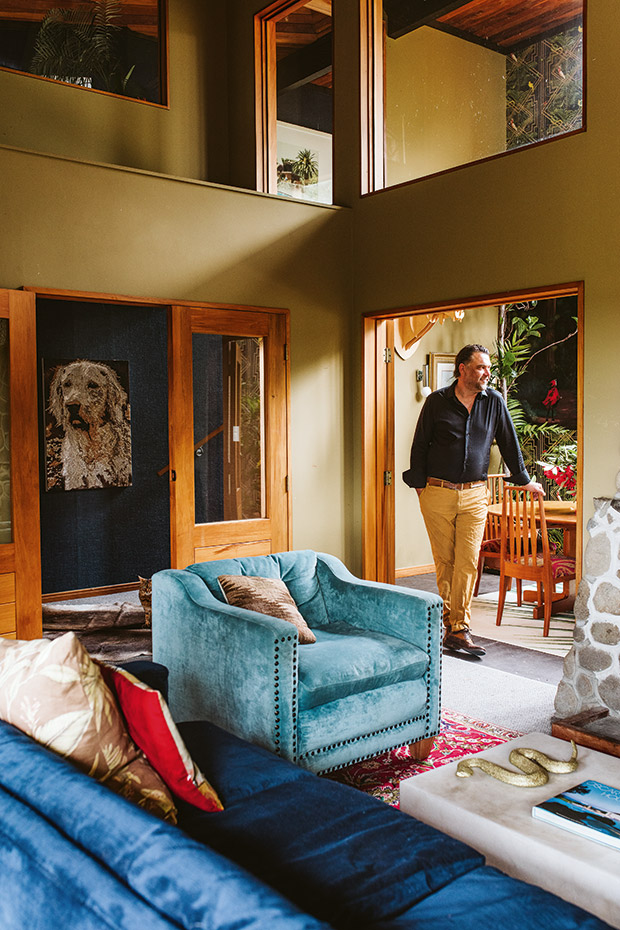
When Mike first saw this house, he was house-hunting on behalf of friends about to move to New Plymouth. “But I walked in and looked down into the lounge through the window above and thought ‘sold’. I liked the house because of the rimu and mataī, which I knew wasn’t cheap. Thankfully, my friends weren’t interested in the house, so I bought it.”
“These gardens had to look good year-round, which is why a lot of people went for formality and structure. Being evergreen, they look good clipped and are manageable. There’s no need to fight plants that are outgrowing their spaces. It was great to bring that formal style to New Zealand when we moved back here in 2001.”
Not that Mike, himself, is at all formal. He’s a designer, sure, but a gardener first. He’s a man who works outdoors, with his hands, in the soil.
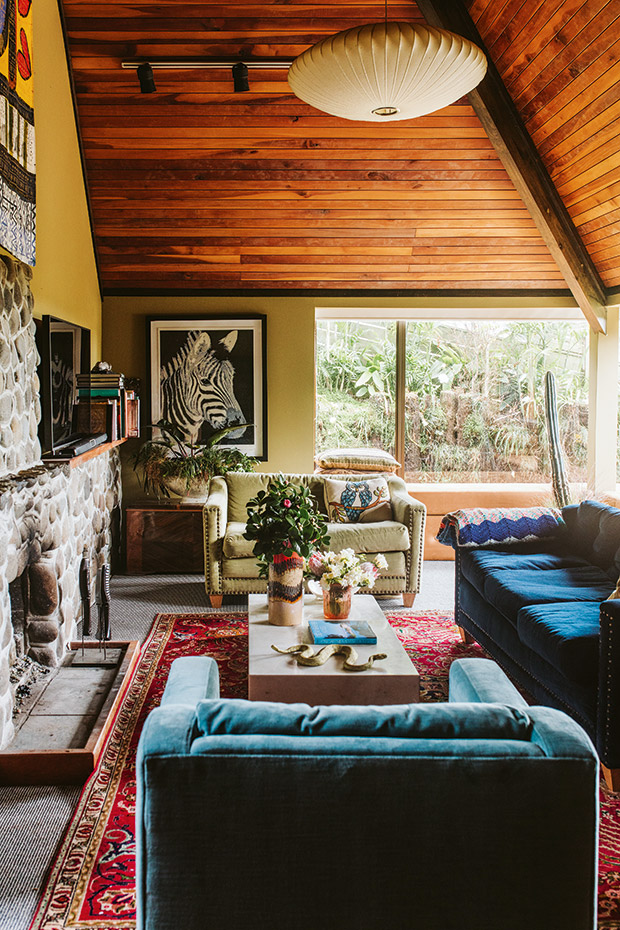
The two animal art works are by Reuben. The dog is a portrait of Ruru, a dog Reuben and Mike shared, now deceased.
“It can be hard to get dressed for the day. I’ll be working with plants, and then I’m supposed to be in meetings, so I can be a bit messy.”
“My hands are rarely clean and are particularly dirty in winter when transplanting, and everything is wet.” And, the thing to get them clean? No fancy gardeners’ soap for Mike: “Those tulle shower poufs are great lathered up.”
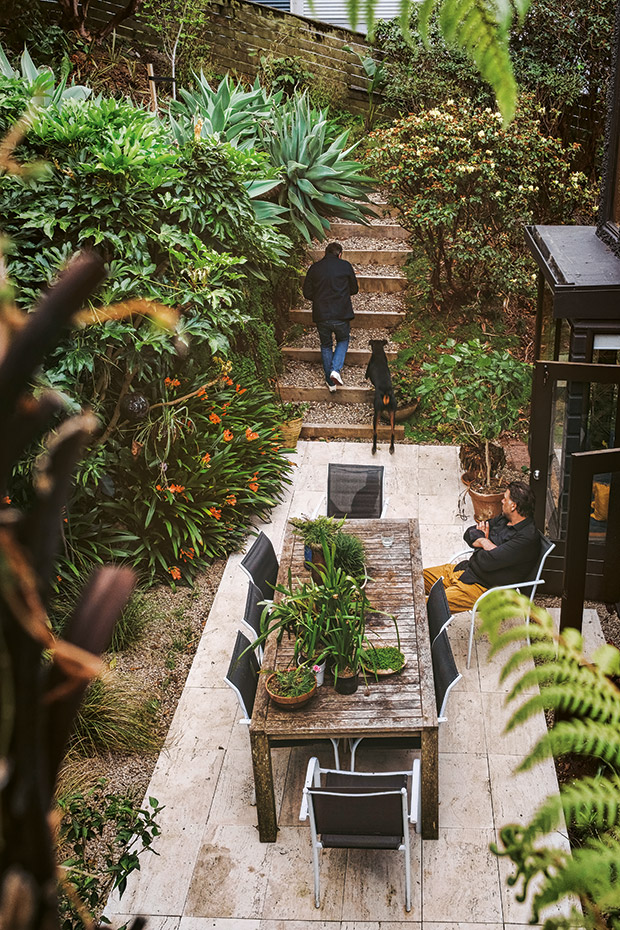
The chances are he scrubbed up a bit for his TVNZ presenting roles on Back to Basics in 2003/2004, and on Mucking In in 2005. “That was a great show to work on. Big budgets. Those were the good old days of lifestyle TV.”
He got his first presenting job by responding to an ad in the Woman’s Weekly. “I’d always wanted to do a show like that; to get people inspired and show them what gardening could be. I liked the presenting side — thinking about what I needed to say in a concise way.”
Mike would love to do another gardening show, especially one that teaches people the nuts and bolts of gardening.
“Working with plants is so poignant right now. It’s what the world needs. Only 20 years ago, gardening was New Zealand’s number-one pastime, but gardening is a skill that’s been lost. When I started out, there were many growers, many breeding magnolias and all sorts of unusual plants. There was a joy in it. But it’s been lost. We have to pass down our knowledge and re-ignite the joy in gardening.”
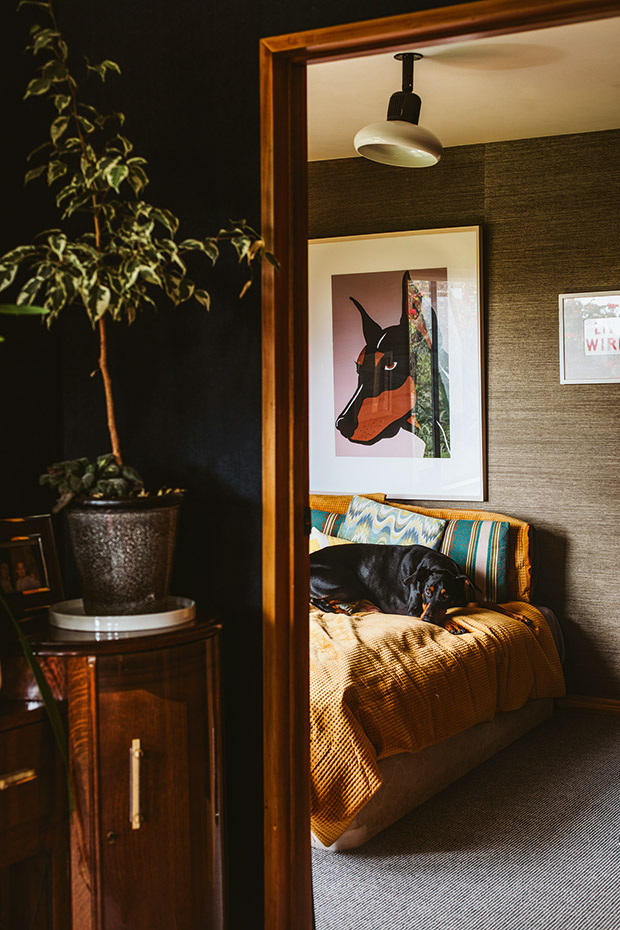
Pluto snoozes on Mike’s eldest son Flynn’s bed. The artwork above is by Pebbles Hooper.
Mike has a lot of joy in his life, not least due to Reuben, his partner of six years and fiancé of one. Mike has undergone quite a life change from being a heterosexual married father — though he is still most certainly a dad.
And he has maintained a relationship with Alisha, but hasn’t always been easy.
“Coming out was certainly an incredibly awkward and difficult time. Alisha is an interior designer, and we were in business together — we were like a power couple. We had the ‘ideal’ marriage. Wed forged the kind of life you wouldn’t leave even under extreme circumstances.
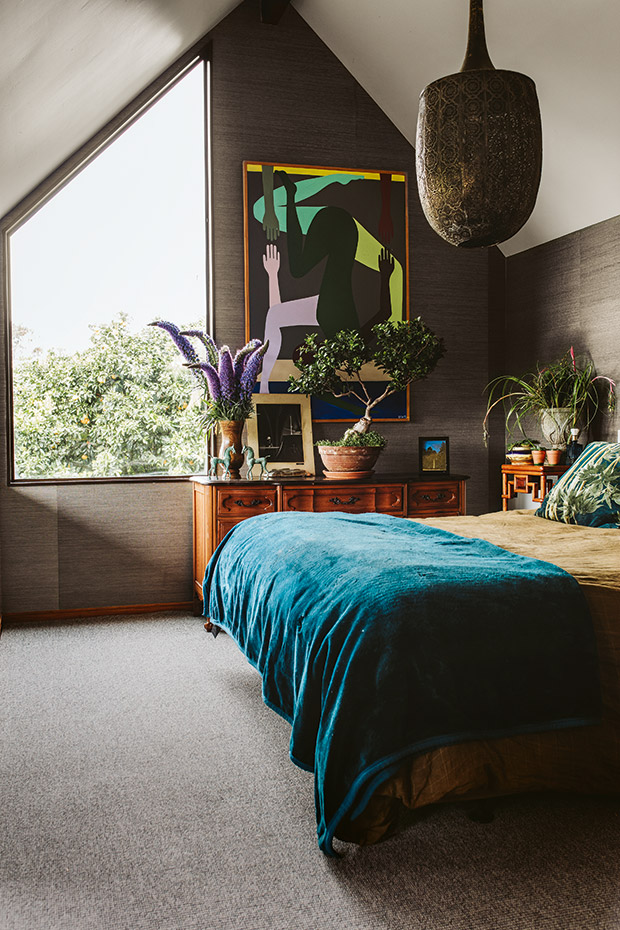
The impressive Moroccan handmade pendant in Mike’s bedroom is from Mitre 10 Mega. “I beg, borrow and steal to get the look I want. Every shop has cool stuff if you know where to look. I generally walk out of the tackiest of shops with something cool. I even get a lot of great stuff from The Warehouse.
“The hardest thing was deciding what was more important, and it boiled down to truth. I started the journey by trying to be happy, but when you hurt people along the way it’s hard. I had four kids who were relying on me, and a wife — of 20 years. We spent two years before the break-up in counseling, trying to make it work. But we weren’t dealing with usual circumstances. It was a difficult thing to navigate as there aren’t many other examples to use to work out if your family is going to be okay.”
About a year later, Mike met Reuben Paterson on a blind date. “He was covered in glitter. He works in glitter, so he’s never short of a little glitter, even after showering,” says Mike. Reuben then had an artists’ residency at the Govett-Brewster Gallery/Len Lye Centre, but the set-up clearly went well as Reuben now owns a home in New Plymouth — replete with a Mike Mansvelt-designed and executed garden.
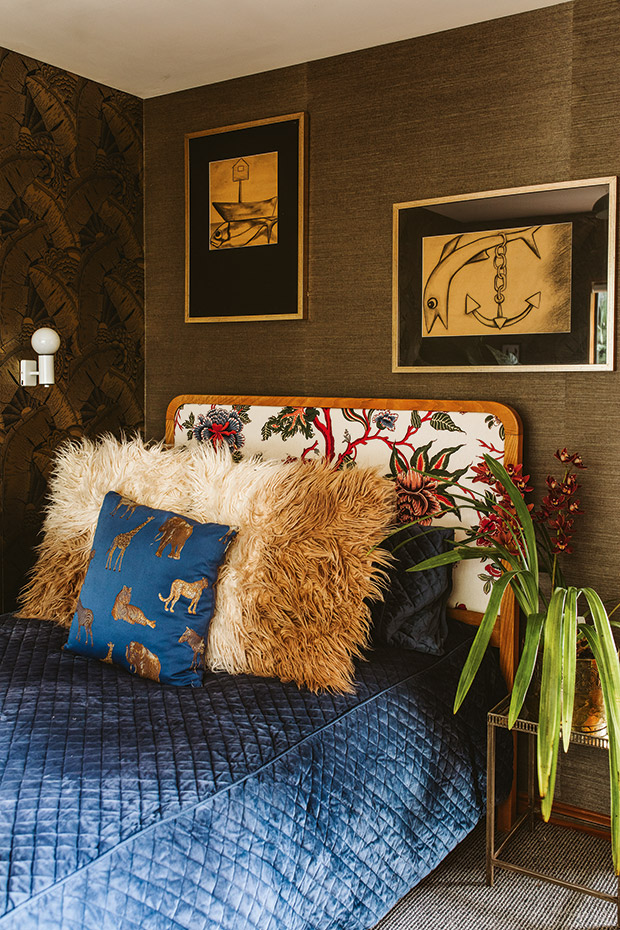
Mike says he wanted these bedrooms, all belonging to his sons, to look different from each other. “But still masculine and fun — like with the recovered French headboard. I love metallic wallpapers — they reflect the light and make dark rooms much brighter. Having contrasting walls — using different colours or textures — instantly makes a small room look bigger. And I love coloured grasscloth; it creates an amazing amount of ambience.”
“Reuben is such a big part of my life. He is the light at the end of the tunnel for me. To me, Reuben is the epitome of masculinity, and what it means to be a gay man. He showed me it’s okay to be gay.” Mike and Reuben have yet to set the wedding date, but there’s sure to be plenty of sparkle, glitter and flowers, most likely in a beautiful setting.
Mike, of course, knows a good-looking garden, having created countless concepts for clients — which can include the house itself, the interiors, the grounds, and even an occasional piece of furniture. One of Mike’s favourite recent jobs was Te Arai Lodge in Matakana, the biggest build to feature on Grand Designs NZ.
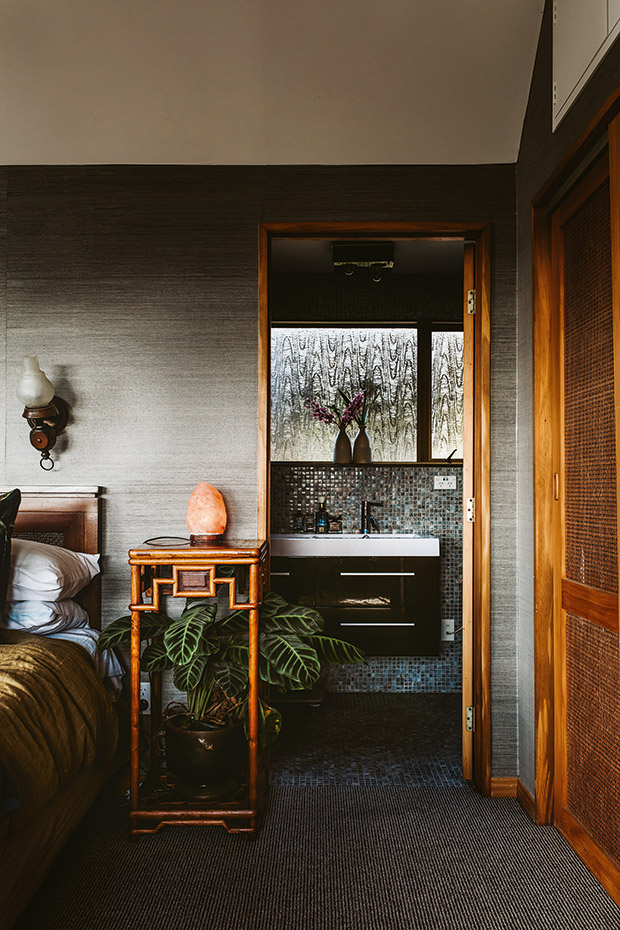
“We did the whole design from scratch, which took four years in the planning alone. It was massive but a lot of fun. The neat thing is the owners are gardeners, so we got to design the whole garden. The property is about being self-sufficient and living off the land, with terraced vegetable beds off the kitchen. It’s also about entertaining, so there’s an amazing chef’s kitchen in tawa. Tawa is an underrated veneer with a beautiful, honeysuckle metallic-ness to it.”
Mike’s keen to design offshore, too.
“I’d love to work in the tropics, maybe at a resort. Yes, that could be about getting a holiday, but I’d love to experiment with a tropical plant palette. I was recently in Bali and couldn’t resist going to the plant centre and buying some plants for the place we were staying at because they were all so cheap. I bought orchids and put them in the trees. It’s such a shame I couldn’t bring any plants back.”
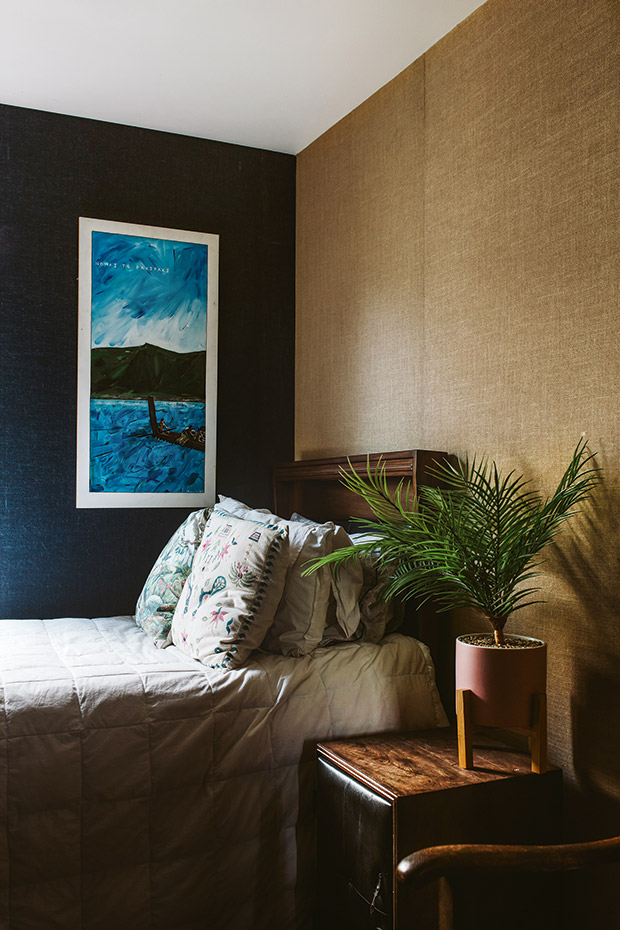
But, for now, he’s happy in New Plymouth, in his 1980s home, tending to his land and his children, and the needs of clients keen for him to make their gardens grow.
THE GARDEN INSIDE
It’s little surprise that Mike Mansvelt’s home is a plant paradise. Plants grow everywhere indoor and out: taking up the dining table, twisting to the massively high ceilings, pretty in pots on the carpet. So, yes, he’s a big fan of indoor plants and the benefits they bring to all areas of the home.
“Pick the plants you like and can deal with. Think about where they’re to be sited. If it’s a sunny position, and you have a palm, you’ll probably underwater it, and it will get covered in mealy bugs. So put the palm somewhere with less sun and swap that spot out with a cactus. Full sun is hardest, as plants can dry out quickly and get stressed.
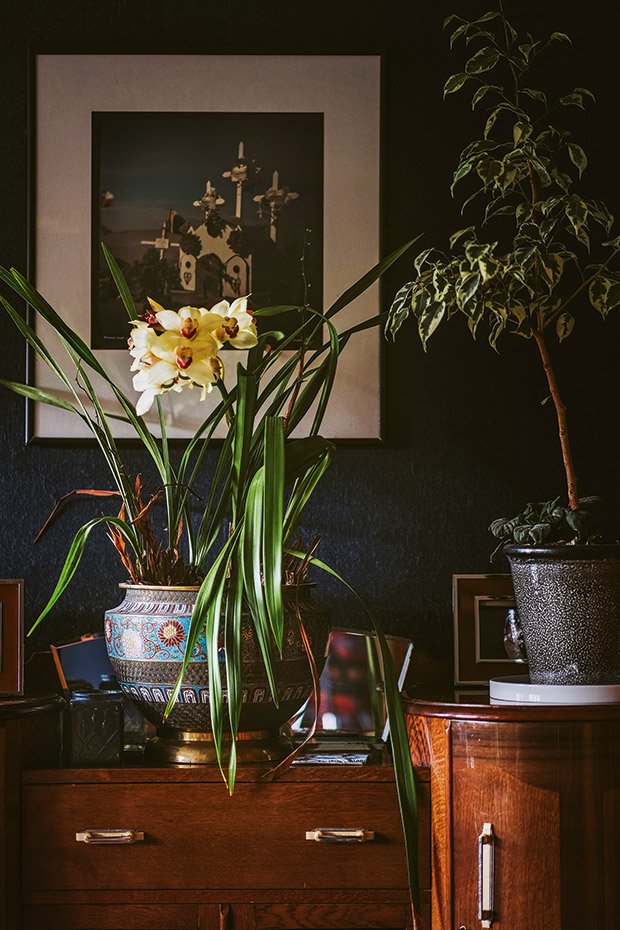
“Indoor plants are a bit of a science — one plant could do well on one side of the room, but not so well on the others. Experiment and don’t be afraid to make mistakes. I’m a pretty good gardener, but indoor gardening is next-level hard. But philodendrons are great because they’re hard to kill and generally vigorous.
“There’s always one that will grow in your house.
“I love using orchids indoors but remember they don’t like temperatures below 15 degrees Celsius. Clivia is easy to grow inside, as are succulents and cacti. Be careful if the plant is sitting on a carpet — I’ve ruined so much carpet by overwatering.”
HOW DOES YOUR GARDEN GROW?
Many gardens aren’t expansive — even Mike’s garden isn’t large — but there are many ways gardeners can make the most of what they have. Mike’s New Plymouth property has a large retaining wall covered with punga logs, ideal as a living wall.
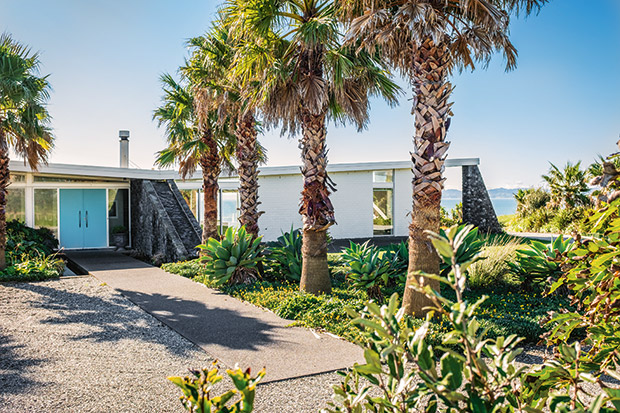
Landscape designer Mike Mansvelt brings lush outdoors into his New Plymouth homeMike completed this client’s house, on the Taranaki coast, in 2011. He designed the interior, exterior and the garden, inspired by a home designed by the modernist Brazilian architect, Oscar Niemeyer. “This house is one of my favourites because I got to do everything I wanted to. Often when you’re building, things drop off. So, the stonework would have been the first to go or the entrance pond. But my clients on this did everything.”
“When I moved into this house four years ago, the punga were starting to rot and crumble, which is a great nursery for epiphytes such as orchids, bromeliads and epiphytic rhododendrons.”
Mike also plants on fences as much as possible.
“That gives me twice as much garden. Plant them out with hanging woolly pockets. Planting up a flat roof is also possible as long as it’s strong enough.
MORE HERE:
Kath Irvine’s pruning fundamentals: When to prune and the three golden rules of pruning
Love this story? Subscribe now!
 This article first appeared in NZ Life & Leisure Magazine.
This article first appeared in NZ Life & Leisure Magazine.
